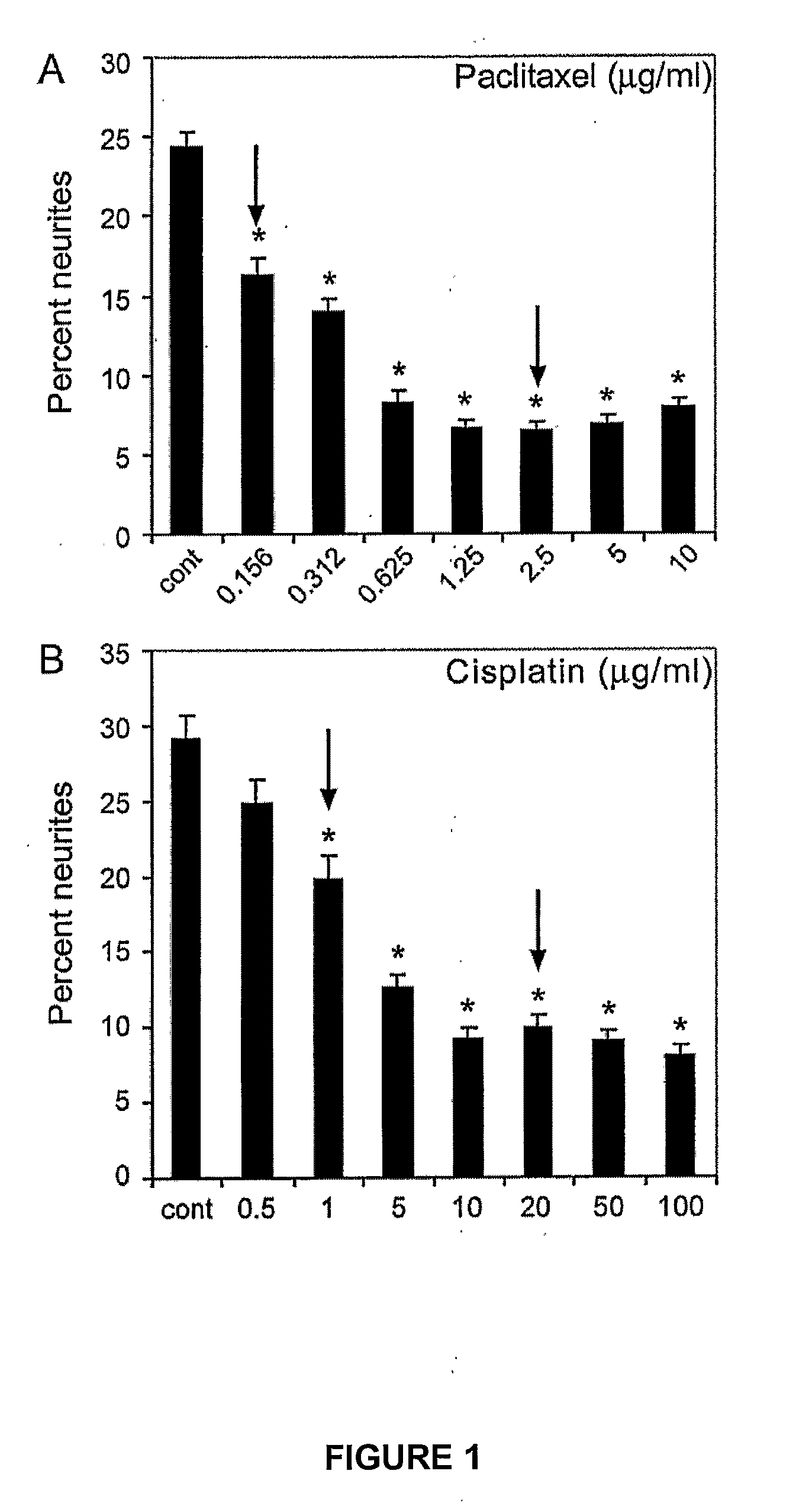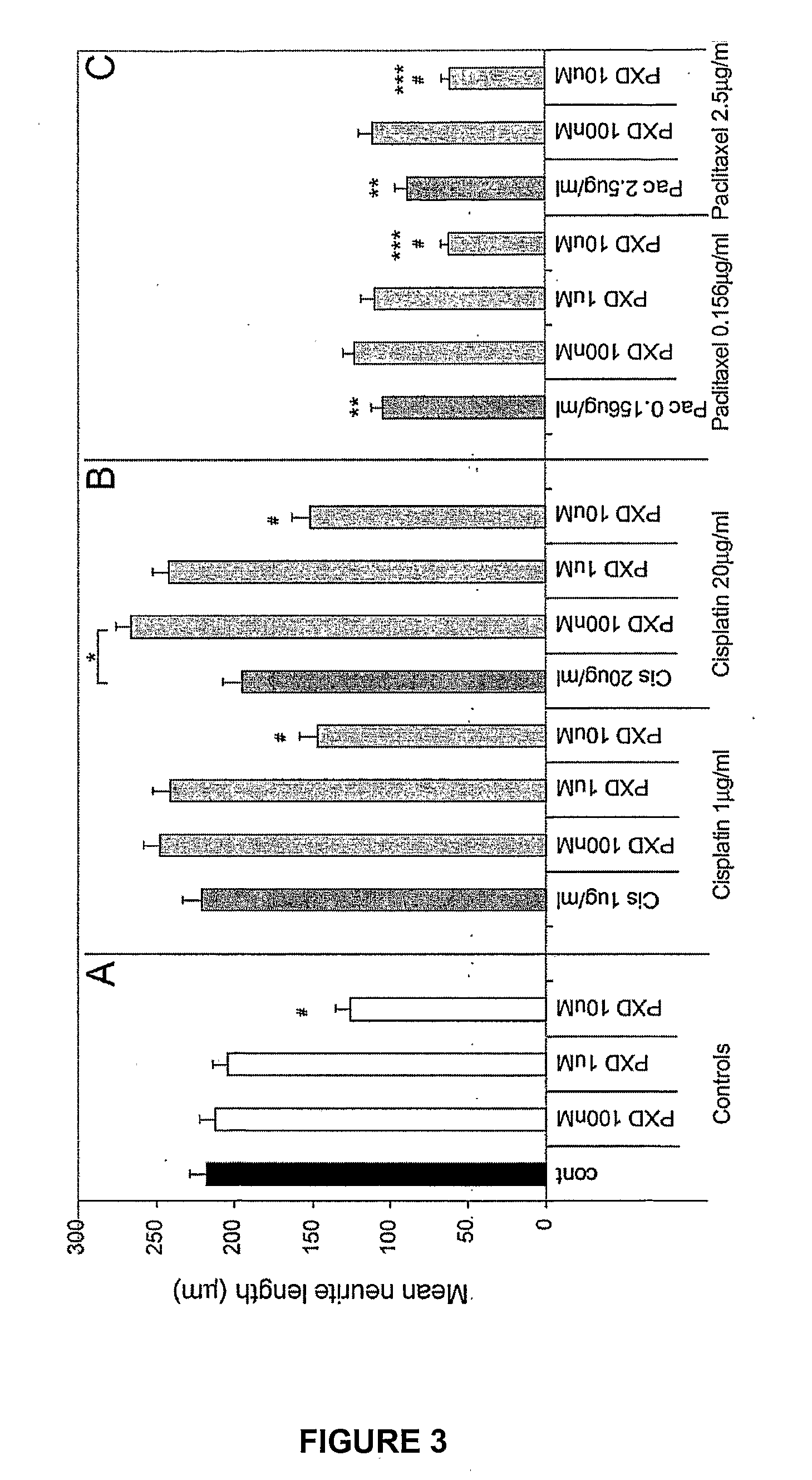Prevention and reversal of chemotherapy-induced peripheral neuropathy
- Summary
- Abstract
- Description
- Claims
- Application Information
AI Technical Summary
Benefits of technology
Problems solved by technology
Method used
Image
Examples
example 1
Neurite Toxicity in the Presence of Cisplatin and Paclitaxel
[0154]Optimal treatment concentrations of cisplatin and paclitaxel that caused neurite damage were determined by treating differentiated PC12 cells for 24 hours with serial dilutions of either drug.
[0155]PC-12 cells were maintained in Dulbecco's Modified Eagle Media (DMEM; Gibco) with 10% calf serum (Turbo calf serum, Invitrogen), 5% horse serum (JRH Biosciences, Victoria, Australia) and 1% penicillin / streptomycin (Invitrogen) at 37° C., in a 5% CO2 atmosphere. Differentiation into neurons was achieved by seeding cells at a density of 15,000 cells / well in 24-well plates (Falcon Becton Dickinson), on 13 mm glass cover slips (Menzel Glaser, Germany) coated with laminin (Invitrogen) and poly-DL-ornithine (Sigma) in DMEM plus 1% horse serum and 50 ng / mL of nerve growth factor (NGF) (Sigma). The cells were incubated for 72 hours under differentiation conditions, before use in the neurite outgrowth assays below.
[0156]Cisplatin (S...
example 2
Effect of Phenoxodiol in Blocking Cisplatin and Paclitaxel Neurite Toxicity
[0161]To determine whether phenoxodiol could block cisplatin or paclitaxel induced neurite toxicity, three different concentrations of phenoxodiol were added to cells in combination with cisplatin or paclitaxel. Combination treatments consisted of a 24 hour incubation in differentiation media with various combinations of strong or moderate doses (so as to produce strong or moderate neurite toxicitiy) of cisplatin (20 μg / ml / 66.65 μM and 1 μg / ml / 3.33 μM) and paclitaxel (2.4 μg / ml / 2.93 μM and 0.156 μg / ml / 0.18 μM) and three doses of phenoxodiol (100 nM, 1 μM, 10 μM) as described in Example 1. Neurite toxicity was determined as the percent of cells comprising neurite outgrowths as described in Example 1.
[0162]Phenoxodiol had no effect on percent neurites at 100 nM or 1 μM but showed significant neurite toxicity at 10 μM (# P<0.001 compared to no treatment control) (FIG. 2A). This neurite toxicity was exacerbated i...
example 3
Effect of Phenoxodiol in Enhancing Recovery from Cisplatin- and Paclitaxel-Induced Neurite Toxicity
[0169]To determine whether phenoxodiol could have an effect on recovery from cisplatin- or paclitaxel-induced neurite toxicity by exacerbation, reversal, retardation or facilitation of repair, recovery experiments were performed. When conducting the recovery experiments, the concentrations of phenoxodiol tested were decreased by 1 log to 10 nM 100 nM and 1 μM. Differentiated PC12 cells were incubated with Cisplatin or Paclitaxel for 24 hrs as described in Example 2, then washed off and cells allowed to recover for 24 hrs in fresh differentiation media before phenoxodiol was added for a further 24 hrs.
[0170]Addition of phenoxodiol at 10 nM, 100 nM or 1 μM alone had no effect on neurite outgrowth (FIG. 5A). After 48 hrs of recovery, cisplatin showed no neurite toxicity at 1 μg / ml but greater than 50% toxicity at 20 μg / ml (*p<0.001) compared to the no treatment control (FIG. 5B), indicati...
PUM
| Property | Measurement | Unit |
|---|---|---|
| Chemotherapeutic properties | aaaaa | aaaaa |
Abstract
Description
Claims
Application Information
 Login to View More
Login to View More - R&D
- Intellectual Property
- Life Sciences
- Materials
- Tech Scout
- Unparalleled Data Quality
- Higher Quality Content
- 60% Fewer Hallucinations
Browse by: Latest US Patents, China's latest patents, Technical Efficacy Thesaurus, Application Domain, Technology Topic, Popular Technical Reports.
© 2025 PatSnap. All rights reserved.Legal|Privacy policy|Modern Slavery Act Transparency Statement|Sitemap|About US| Contact US: help@patsnap.com



